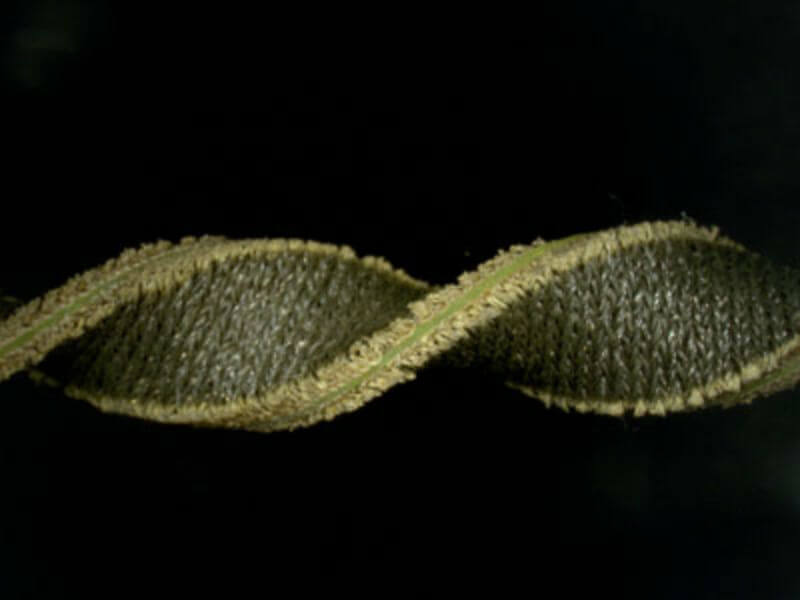Wearable technologies – from heart rate monitors to virtual reality headsets – are exploding in popularity in both the consumer and research spaces, but most of the electronic sensors that detect and transmit data from wearables are made of hard, inflexible materials that can restrict both the wearer’s natural movements and the accuracy of the data collected. Now, a team of researchers at the Harvard John A. Paulson School of Engineering and Applied Sciences (SEAS) and the Wyss Institute for Biologically Inspired Engineering at Harvard University has created a highly sensitive soft capacitive sensor made of silicone and fabric that moves and flexes with the human body to unobtrusively and accurately detect movement.
“We’re really excited about this sensor because, by leveraging textiles in its construction, it is inherently suitable for integration with fabric to make ‘smart’ robotic apparel,” said corresponding author Conor Walsh, the John L. Loeb Associate Professor of Engineering and Applied Sciences at SEAS and Core Faculty member at the Wyss Institute.
“Additionally, we have designed a unique batch-manufacturing process that allows us to create custom-shaped sensors that share uniform properties, making it possible to quickly fabricate them for a given application,” said co-author Ozgur Atalay, a postdoctoral fellow at the Wyss Institute. This research is published in the current issue of Advanced Materials Technologies, and the protocol is available as part of the Harvard Biodesign Lab’s Soft Robotics Toolkit.
The team’s technology consists of a thin sheet of silicone (a poorly conductive material) sandwiched between two layers of silver-plated, conductive fabric (a highly conductive material), forming a capacitive sensor. This type of sensor registers movement by measuring the change in capacitance, or the ability to hold electrical charge, of the electrical field between the two electrodes.
“When we apply strain by pulling on the sensor from the ends, the silicone layer gets thinner and the conductive fabric layers get closer together, which changes the capacitance of the sensor in a way that’s proportional to the amount of strain applied, so we can measure how much the sensor is changing shape,” said co-author Daniel Vogt, a research engineer at the Wyss Institute.
The hybrid sensor’s superior performance stems from its novel manufacturing process, in which the fabric is attached to both sides of the silicone core with an additional layer of liquid silicone that is subsequently cured. This method allows the silicone to fill some of the air gaps in the fabric, mechanically locking it to the silicone and increasing the surface area available for distributing strain and storing electrical charge. This silicone-textile hybrid improves sensitivity to movement by capitalizing on the qualities of both materials: the strong, interlocking fabric fibers help limit how much the silicone deforms while stretching, and the silicone helps the fabric return to its original shape after strain is removed. Finally, thin, flexible wires are permanently attached to the conductive fabric with thermal seam tape, allowing electrical information from the sensor to be transmitted to a circuit without a hard, bulky interface.
The team evaluated their new sensor design by performing strain experiments in which various measurements are taken as the sensor is stretched by an electromechanical tester. Generally, as an elastic material is pulled, its length increases while its thickness and width decrease, so the total area of the material – and, therefore, its capacitance – stays constant. Surprisingly, the researchers found that the conductive area of their sensor increased as it was stretched, resulting in greater-than-expected capacitance.
“Silicone-based capacitive sensors have limited sensitivity based on the nature of material. Embedding the silicone in conductive fabric, however, created a matrix that prevented the silicone from shrinking as much width-wise, which improved sensitivity above that of the bare silicone we tested,” said lead author Asli Atalay, a postdoctoral fellow at the Wyss Institute.
The hybrid sensor detected increases in capacitance within 30 milliseconds of strain application and physical changes of less than half a millimeter, confirming that it is capable of capturing movement on the scale of the human body. To test that ability in a real-world scenario, the team integrated a set of them into a glove to measure fine-motor hand and finger movements in real time. The sensors were successfully able to detect capacitance changes on individual fingers as they moved, indicating their relative positions over time.
“Our sensor’s greater sensitivity means it has the ability to distinguish smaller movements, like slightly moving one finger side-to-side rather than simply whether the whole hand is open or clenched in a fist,” said co-author Vanessa Sanchez, a graduate student in the Biodesign Lab at SEAS.
While this study is a preliminary proof-of-concept, the team is excited about the many future directions in which this technology could develop.
“This work represents our growing interest in leveraging textile technology in robotic systems, and we see promising applications for motion capture ‘in the wild,’ such as athletic clothing that tracks physical performance or soft clinical devices to monitor patients in their homes. In addition, when combined with fabric-based soft actuators, these sensors will enable new robotic systems that truly mimic apparel,” said Walsh.
If our reporting has informed or inspired you, please consider making a donation. Every contribution, no matter the size, empowers us to continue delivering accurate, engaging, and trustworthy science and medical news. Independent journalism requires time, effort, and resources—your support ensures we can keep uncovering the stories that matter most to you.
Join us in making knowledge accessible and impactful. Thank you for standing with us!

